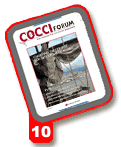COCCI FAQsSchering-Plough’s tech service team answers questions about managing coccidiosis in broilers.
Q. WHICH TECHNOLOGY DOES
SCHERING-PLOUGH RECOMMEND TO HELP ENSURE EFFICIENT, UNIFORM APPLICATION AND SUCCESSFUL COCCIDIOSIS CONTROL?
The Spraycox 2 machine with the
dual nozzle system for application
on chicks has improved vaccination
coverage by utilizing a more efficient
spray pattern, which increases the
amount of vaccine applied directly to
the chicks. Our new AirMix technology
(see page 32) keeps the vaccine’s
oocysts suspended to ensure optimum
performance. Data collected from an industry reporting service in 2003 and 2004 show that Coccivac-B programs outperform standard anticoccidial programs in all major flock performance parameters, even during the hottest months of the year. More companies are realizing this advantage and are considering extension of their Coccivac-B summer programs well into winter. A few complexes have used Coccivac-B yearround with great success. Company nutritionists are beginning to realize that they have more opportunities to use creative diets once restrictive, in-feed anticoccidials are removed from the formulation equation. With the recent paradigm shift from in-feed anticoccidials to Coccivac-B, the possibilities for maximizing flock performance are endless, and many of them are already coming to fruition. Q. WHAT IS THE MINIMUM TARGET
WEIGHT OF BIRDS THAT CAN RECEIVE
COCCIVAC-B AND STILL PRODUCE POSITIVE
ECONOMIC RETURNS?
Vaccine application and flock management tend to be more critical in small bird weight (<4.5 lbs) operations because of tighter densities and higher levels of coccidial field challenges. Densities are higher because birds are placed based on pounds per square feet in most poultry operations. But, with respect to oocyst output, the number of birds per square feet is more important because each bird is literally a coccidial, oocyst-producing machine. In general, the more birds there are
per square feet, the more oocysts there
are per square feet; yet, if the coccidial
field challenge is under control and
birds are properly vaccinated and managed,
small weight flocks tend to do
well on a Coccivac-B program. In addition, research at Colorado
Quality Research has shown that in
Coccivac-B vaccinated birds, roxarsone
has a positive impact on live production
performance parameters such as
weight gain and feed conversion ratio. Vaccinates 7 through 21 days of age should also be observed in the field for signs of necrotic enteritis or management practices that are incompatible with controlled vaccine cycling. Thereafter, flocks should be monitored
by monthly postmortem sessions
including representatives from 14 days
of age through slaughter, with an
emphasis on ages 21 through 35 days. Data suggest that improved levels of total sulfur amino acids in the first 2 to 3 weeks is linked to better performance in broilers receiving Coccivac-B. Extra fortification with fat-soluble vitamins (D and E) during peak vaccinal oocyst cycling may improve performance. Vitamin D supplemented at 40,000 to 60,000 IU in the starter feed is recommended. The ration must be formulated to enhance growth from day 28 through slaughter, maximizing compensatory gain. Very low protein diets should be avoided. Pay special attention to the digestibility of raw materials in the starter feed. Subtherapeutic levels of antibiotics with anticlostridium activity (bacitracin, virginiamycin, etc.) or with the ability to manage intestinal microflora composition (bambermycin) are highly recommended during the immunity-building phase of vaccination to prevent secondary necrotic enteritis. If wheat, barley or rye is a significant ration component, appropriate enzymes should be incorporated to minimize the incidence of necrotic enteritis by removing fish meal or animal proteins. Do not use any drugs with anticoccidial activity for the first 2 weeks after vaccination in broilers and for at least 4 weeks after vaccinating other long-life birds, such as broiler breeders. |




 © 2000 - 2021. Global Ag MediaNinguna parte de este sitio puede ser reproducida sin previa autorización.
© 2000 - 2021. Global Ag MediaNinguna parte de este sitio puede ser reproducida sin previa autorización.